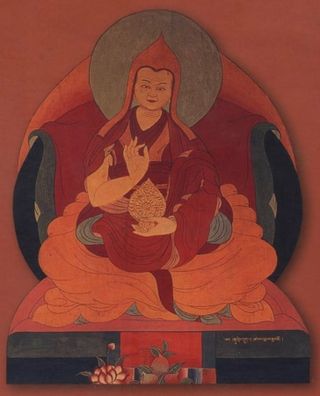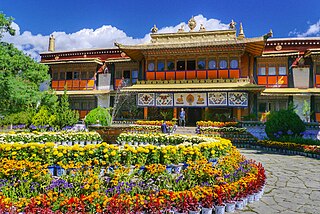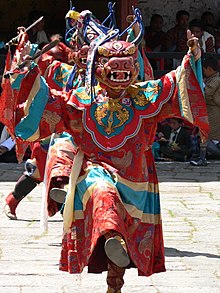
The 6th Dalai Lama, Tsangyang Gyatso, was recognized as the 6th Dalai Lama after a delay of many years, permitting the Potala Palace to be completed. He was an unconventional Dalai Lama that preferred a Nyingma school yogi's life to that of an ordained monk. He was later kidnapped and deposed by the Koshut Lha-bzang Khan.

Samye, full name Samye Mighur Lhundrub Tsula Khang and Shrine of Unchanging Spontaneous Presence, is the first Tibetan Buddhist and Nyingma monastery built in Tibet, during the reign of King Trisong Deutsen. Shantarakshita began construction around 763, and Tibetan Vajrayana founder Guru Padmasambhava tamed the local spirits for its completion in 779. The first Tibetan monks were ordained there. Samye was destroyed during the Cultural Revolution then rebuilt after 1988.

The 7th Dalai Lama, Kelzang Gyatso, was recognized as the authentic 7th Dalai Lama of Tibet. He was seen as the true incarnation of the 6th Dalai Lama, and was enthroned after a pretender supported by the Koshut Khan was deposed.

The 5th Dalai Lama, Ngawang Lobsang Gyatso was recognized as the 5th Dalai Lama, and he became the first Dalai Lama to hold both Tibet's political and spiritual leadership roles. He is often referred to simply as the Great Fifth, being the key religious and temporal leader of Tibetan Buddhism and Tibet. He is credited with unifying all of Tibet under the Ganden Phodrang, after Gushri Khan's successful military interventions. As an independent head of state, he established priest and patron relations with both Mongolia and the Qing dynasty simultaneously, and had positive relations with other neighboring countries. He began the custom of meeting early European explorers. The 5th Dalai Lama built the Potala Palace, and also wrote 24 volumes' worth of scholarly and religious works on a wide range of subjects.

Norbulingka is a palace and surrounding park in Lhasa, China built from 1755. It served as the traditional summer residence of the successive Dalai Lamas from the 1780s up until the 14th Dalai Lama's exile in 1959. Part of the "Historic Ensemble of the Potala Palace", Norbulingka is recognized as a UNESCO World Heritage Site, and was added as an extension of this Historic Ensemble in 2001. It was built by the 7th Dalai Lama and served both as administrative centre and religious centre. It is a unique representation of Tibetan palace architecture.

Tibet developed a distinct culture due to its geographic and climatic conditions. While influenced by neighboring cultures from China, India, and Nepal, the Himalayan region's remoteness and inaccessibility have preserved distinct local influences, and stimulated the development of its distinct culture.

The Nechung Oracle is the personal oracle of the Dalai Lama since the second Dalai Lama. The medium currently resides in Nechung Monastery established by the Dalai Lama in Dharamsala, India. The Nechung Oracle was the designated head of the Nechung monastery in Tibet.

Palden Lhamo or Shri Devi is a tantric Buddhist (Vajrayana) goddess who appears in various forms. She usually appears as a wrathful deity with a primary role as a dharmapala. She is specifically a Wisdom Protector, an enlightened being.

Nechung Monastery, Nechung Gompa or Nechung Chok, is the seat of the State Oracle of Tibet. It is also referred to as Sungi Gyelpoi Tsenkar, the "Demon Fortress of the Oracle King."

Ngamring County is a county of Xigazê in the Tibet Autonomous Region, China. "Ngamring County, sometimes referred to as the gateway to Mount Kailash and Far West Tibet, is the barren area which divides the Raga Tsangpo and the Brahmaputra."

The Sho Dun Festival, commonly known as the Shoton or Yogurt Festival or Banquet since "Sho" means Yogurt and "Dun" means Banquet, is an annual festival held at Norbulingka or "Jewel Park" palace in Lhasa, Tibet Autonomous Region.

The Tibetan Institute of Performing Arts (TIPA) was founded by Tenzin Gyatso, the 14th Dalai Lama on reaching McLeod Ganj, Himachal Pradesh, India in exile from Tibet in August 1959. It was then called Tibetan Music, Dance and Drama Society, which was one of the first institutes set up by the Dalai Lama, and was established to preserve Tibetan artistic heritage, especially opera, dance, and music.
Lhamo Latso or Lha-mo La-tso is a small oval oracle lake where senior Tibetan monks of the Gelug sect go for visions to assist in the discovery of reincarnations of the Dalai Lamas. Other pilgrims also come to seek visions. It is considered to be the most sacred lake in Tibet.

Thangtong Gyalpo, also known as Chakzampa, the "Iron Bridge Maker", Tsöndrü Zangpo "Excellent Persistence", and the King of the Empty Plain. He was also known by a variation of this name, Madman of the Empty Valley. He was a great Buddhist adept, a Chöd master, yogi, physician, blacksmith, architect, and a pioneering civil engineer. He is considered a mind emanation of Padmasambhava and a reincarnation of Dolpopa Sherab Gyaltsen. He founded the Iron Chain lineage of the Shangpa Kagyu school of Tibetan Buddhism, and he recognized the first Samding Dorje Phagmo, Chökyi Drönma (1422–1455), the female incarnation lineage of Vajravārāhī.
The Nyethang Drolma Temple is a temple in Nyêtang in the Tibet Autonomous Region of China dedicated to Tara. It is associated with Atiśa (980–1054), who founded the Kadam school of Tibetan Buddhism. The monastery survived the Cultural Revolution relatively undamaged. It is dedicated to Tara, a female bodhisattva, and contains many statues and paintings of Tara.

The Samding Dorje Phagmo is the highest female incarnation in Tibet and the third highest-ranking person in the hierarchy after the Dalai Lama and the Panchen Lama. She was listed among the highest-ranking reincarnations at the time of the 5th Dalai Lama, recognized by the Tibetan government and acknowledged by the emperors of Qing China. In her first incarnation, as Chökyi Drönma, she was the student and consort of the famous polymath Thang Tong Gyalpo, who first identified her as an emanation of Vajravārāhī, and the consort of Bodong Panchen. The seat of the Samding Dorje Phagmo is at Samding Monastery, in Tibet.

Keutsang Hermitage is a historical hermitage, belonging to the Sera Monastery, about 8 kilometres (26,000 ft) northwest of Lhasa in Tibet Autonomous Region. The hermitage was in a precariously perched cave once inhabited by the great Tibetan guru Tsongkhapa. However, the original cave collapsed in a landslide. What is present now was rebuilt, adjoining the ruined Keutsang West Hermitage, at a safer location. As it exists now, Keutsang is to the east of Sera on a hillside above Lhasa’s principal cemetery. Rakhadrak Hermitage is above and close to this hermitage.

Chupzang Nunnery(Chu bzang dgon) is a historical nunnery, belonging to Sera Monastery. It is located north of Lhasa in Tibet, China. Though the site was established as a hermitage around 1665, it was converted into an exclusive nunnery in 1984 and has since grown into one of the largest nunneries in the Lhasa Valley.

Polhané Sönam Topgyé was one of the most important political personalities of Tibet in the first half of the 18th century. Between 1728 and 1747 he was effectively the ruling prince of Tibet and carried royal titles during the period of Qing rule of Tibet. He is known as an excellent administrator, a fearsome warrior and a grand strategist. After the troubled years under the reign of Lhazang Khan, the bloody invasion of Tsering Dhondup and the civil war, his government ushered in a relatively long period of stability and internal and external peace for Tibet.

Chökyi Drönma (1422-1455) was a Tibetan princess and Buddhist leader. She was the main consort of Thang Tong Gyalpo, who recognized her as an emanation of Machig Labdrön through the lineage of Vajravārāhī and appointed her as the first Samding Dorje Phagmo.






















